“For in their interflowing aggregate, those grand freshwater seas of ours—Erie, and Ontario, and Huron, and Superior, and Michigan—possess an ocean-like expansiveness, with many of the ocean’s noblest traits.”
Herman Melville, Moby Dick
Recently, the planets aligned for me: Summer Fridays started at work, our house- and pet-sitter was available with just a couple days’ notice, and I had also just handed off some huge work projects. While at a Kentucky lake house rental just the week before, some things showed up for my husband John and me, and we felt a call to visit Michigan and the Great Lakes. Long story short: We did. I grew up near Lake Michigan and have also been to Lake Ontario while visiting Toronto, but hadn’t been to the others—Huron, Erie, or Superior. So, we left from Nashville very early on Friday morning, drove an hour and a half to Bowling Green, Kentucky, stopped at a fantastic coffee shop that I had visited before and knew would be great for camping out for several hours, worked until 1:00 pm, then headed northeast to spend a little time in Ohio, which we hadn’t done before. A quick overnight in a small town between Cincinnati and Toledo, and then by early Saturday morning we were in Michigan. We had a quick peek at Lake Erie for breakfast and lunch with Lake Huron a couple days later. And then a nice long two-day reunion with the lake I grew up going to, visiting several adorable beach towns along the way.
Here are some of the things I discovered this week that I thought you might enjoy.
1. Something that surprised me.
When we crossed the border from Ohio to Michigan, we headed toward a little town called Luna Pier—mainly because we wanted to peep Lake Erie (and also because we have a bird named Luna). After living in Southern California for more than two decades, I’m ashamed to admit that I had forgotten that there are really beautiful and vast lakefront beaches! If you’ve never been to a Great Lakes beach, you’re missing out. (Also: No sharks, no jellyfish.)
What surprised me was not only did this feel like I was on a small stretch of the Pacific for a moment, but also this tiny town has canals designed to provide access to Lake Erie from the “Venice” residential area, named for Venice, Italy. They’re not as large and maintained as the ones I was used to seeing in places like Venice, California, but this reminded me that there are so many cool, unusual, and unexpected places in the world. I found out later that these canals are currently not usable for larger boats, only canoes and very small motorboats, as the canals have become filled with dirt and sediment and require dredging to restore them back to full working order.
Another fun fact: There’s a VRBO you can rent that was originally the hideout of “Pretty Boy Floyd,” who was a bank robber and gangster in the 1930s. According to the listing, this is the “actual Pretty Boy Floyd Hideout, corroborated by eyewitnesses at the time on tape! He walked in the now Key bank in Sylvania, Ohio, with Michigan license plates and robbed the bank, got away, and this was his hideout! He was later caught in Toledo, Ohio, and sentenced to 12-15 years in the Columbus, Ohio, State penitentiary. On the train ride down he jumped out the bathroom window of the moving train and went on to rob banks for another four years. Public enemy #1 ambiance of most famous gangster.”
If you’re a history buff looking for something quirky and off the beaten path, this could be an interesting weekend “getaway.” (Pun intended.)
2. Something that wowed me.
One of the places I wanted to visit—and a primary reason for heading to the Ann Arbor area—was the Matthaei Botanical Gardens and Nichols Arboretum. I was drawn there because of their mission statement, which is stated on their website and happens to be aligned with so many of my values and passions:
Matthaei Botanical Gardens and Nichols Arboretum is a transformative force for social and ecological resilience through the waters and lands we steward. We turn this commitment into action by:
Positioning humans as active participants within the natural world and compelling the university community and our publics to negotiate the full complexity that entails.
Advancing partnerships, programs, and all that we steward to catalyze access and impact in a radically changing world.
Emerging as University of Michigan’s premier partner for research, teaching, and public impact in sustainability, climate-forward practices, and biocultural diversity.
Promoting healthier communities, cultures, and ecosystems through active care and cultivation of the gardens, fields, natural habitats, and dynamic systems that sustain our world.
We wandered part of the grounds and the botanical garden (which reminded me of the botanical building in Balboa Park in San Diego, one of my most favorite places to visit and photograph), and while there, they happened to have a bonsai and penjing exhibit on display. I’ve seen many bonsai before and even have a small tree I’ve been growing for six years, though I haven’t started “training” it, as it hasn’t seemed to need it yet. I don’t give this tiny tree as much thought as I probably could—or maybe should. I’m also so used to my other plants growing so quickly, and I have often wondered if maybe I didn’t have a “real” bonsai. But when I saw that some of these trees at the exhibit were started long before I was even born, and that some don’t get trained until many years later—sometimes upward of twenty years, and more in some cases—I realized that bonsai is a lifelong art, lesson, and pursuit. In a strange way, it gave me a new kind of hope—and lit a small fire for me.
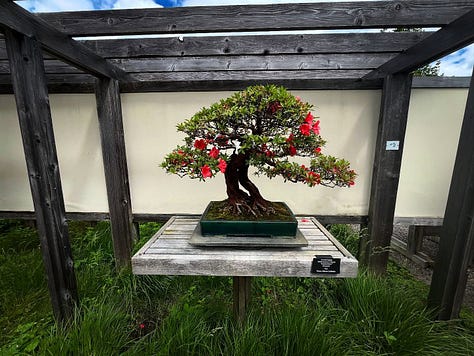
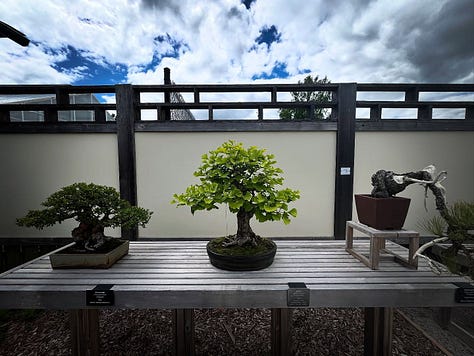
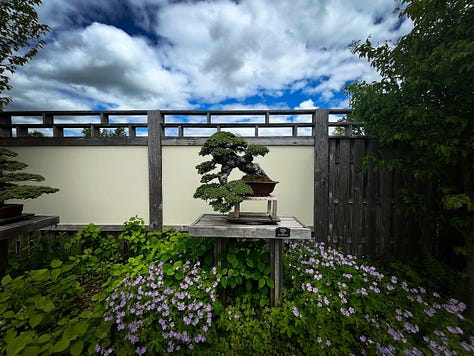
Their beauty alone wowed me, but then I saw something that left me in awe: a thousand-year-old Rocky Mountain Juniper (Juniperus scopulorum) bonsai.
If you’re interested in getting started with bonsai, you can likely find some young trees at your local nursery. And if you’d like or order something online, you can get started with a beautiful tree for as little as thirty bucks. I am considering ordering from this place myself:
Not only did this exhibit ignite something for me, but it also made me wonder, How did this tiny tree last for so long???
Which led me to . . .
3. Something I learned.
The bonsai tree is a symbol of peace, harmony, and luck. When given as a gift, it can symbolize loyalty, love, and respect. In Japan, bonsai trees are therefore often passed down from generation to generation as treasured heirlooms. Since they can live for hundreds of years with proper care, they are often left to family members in their wills, estates, and trusts.
And in case you ever find yourself in the position to inherit one, and begin thinking, Grandpa went to heaven and all I got was this lousy old plant? Consider that a very old tree can be worth up to $400,000.00.
How amazing would it be to begin growing and cultivating something now that could potentially sustain family members that you might never meet? Or at the very least, become a beautiful connection to the past.
All of this reminded me that I still need to pull together my will and get some affairs in order, and decide what goes where in case something happens to my husband and me at the same time. Where should our pets go? What about family photos? Historical papers? The letters and telegrams that Grandpa sent during World War II? My mother-in-law’s jewelry?
But I had never considered, What happens to my plants? I don’t even know anyone near me who loves plants as much as I do (if I do, speak now . . . ), and so many of my closest friends nearby have self-proclaimed brown thumbs. I’ve given away or sold my plants in the past when I’ve moved, but the collection I have now has become really special to me for various reasons. Some of them were gifts from my mom. Some were my mother-in-law’s that I rescued as her health declined. Others were gifts given to me at their losses. Some are simply gifts from friends, and a few others were sent to me for revival when my brown-thumb friends didn’t know how to keep their plants alive.
So, if you are a plant lover and enthusiast like me, and are concerned about what might happen to your plants when you’re no longer here, here are some things I learned:
To include plants in a will, you need to specifically name them and specify who should inherit them. You can do this by listing individual plants or by assigning them to specific individuals or trusts. This is particularly useful for rare or valuable plants.
Here’s a concise, step-by-step list of instructions for leaving plants to someone in a will or estate:
Inventory Your Plants: Create a detailed list of the plants you wish to bequeath, including their common names, specific varieties (if known), and any unique characteristics or sentimental value.
Identify Beneficiaries: Clearly state who you want to receive each plant or collection of plants. Include full legal names and current contact information for each beneficiary.
Specify Instructions:
Specific Bequests: For individual plants, write: “I give my [Plant Name/Description] to [Beneficiary's Full Name].”
Collection Bequests: For groups of plants: “I give all of my [Type of Plant, e.g., orchids, houseplants] to [Beneficiary's Full Name].”
Residuary Clause (Optional but Recommended): Consider a clause for any plants not specifically mentioned, such as: “Any remaining plants not specifically bequeathed shall be given to [Beneficiary's Full Name] or sold, with proceeds added to my residuary estate.”
Consider Contingencies: What if a beneficiary predeceases you or doesn't want the plants? Include alternate beneficiaries or instructions for how the plants should be handled in such cases (e.g., “If [Beneficiary’s Full Name] does not survive me or declines the [Plant Name], then I give the [Plant Name] to [Alternate Beneficiary’s Full Name]”).
Address Care and Transport: Briefly outline any special care instructions for unique or delicate plants. You might also specify who is responsible for transporting the plants (e.g., “My executor shall arrange for the delivery of these plants to the named beneficiaries, with reasonable transportation costs paid from my estate”).
Consult an Attorney: This is the most crucial step. Provide your inventory and instructions to a qualified estate planning attorney. They will ensure your wishes are legally binding and properly incorporated into your will or trust, adhering to the specific laws of your jurisdiction. Do not attempt to draft this yourself without legal counsel.
Review and Update: Periodically review your will, especially if your plant collection changes significantly or if your beneficiaries’ circumstances change.
4. Something I found.
While traveling and exploring “the mitten,” one of the places I really wanted to visit was a little beachside town called Petoskey. Learning about this charming fishing village, I discovered that one of the favorite pastimes of residents and tourists is looking for “Petoskey stones.” As a lifelong shell and rock collector, naturally this was something I needed to do. I read that sometimes it can take hours to find one, if ever at all. But in the same way that some rare people can look down at a patch of clover and find one with four leaves, I was there for about two minutes when I looked down and found something special.
[Side note: As a teen, I once knew someone who defied odds and would find four-leaf clovers regularly. He found them so often, he would just give them away, often handing them to whomever he was around, and had given me several. I had them pressed inside pages of a book for years. Apparently, some people have better visual acuity, so if you want to improve your odds of finding one, try looking more for the overall shape of the clover rather than counting leaves: look for more square v. triangular shapes. I have yet to find one myself.]
What is a Petoskey stone anyway?
Glad you asked. A Petoskey stone is Michigan’s official state stone, a fossilized coral (Hexagonaria percarinata) from the Devonian Period (around 350 million years ago). When wet or polished, it reveals a distinctive, intricate honeycomb-like pattern formed by the preserved skeletons of ancient coral polyps.
I couldn’t tell if my find was a true Petoskey, but later that day, I visited a brand-new darling independent bookstore in Charlevoix called Dockside Books—which had been open for only eleven days at the time, and is also certified climate neutral—and met the lovely owner who said she didn’t think it was a Petoskey stone, but looked more like a Charlevoix stone, or favosite, to her.
Wait—there’s more?
“It’s definitely a fossil of some sort,” she said, then gifted me an illustrated bookmark that showed several types of fossilized stones of Michigan.
Favosite or not, I’m very happy to find this little fossilized gem.
Disclaimer: Wherever you go, be sure to check local laws for whether or not you’re allowed to remove something from the environment, as there are many protected lands and laws created as a result. When rock hunting, it’s extremely important to be aware of any state or federal laws. For example: According to the DNR, you are only allowed to remove 25 lbs of stones per year from state land. And if any Petoskey Stone weighs over 25 lbs, the DNR has the right to confiscate it. Keep in mind that in some protected lands, there’s a “look but don’t touch” policy.
5. Something beautiful.
The illustrated bookmark I received from the bookstore owner was by a former Michigan artist named Grace You, owner of Papermiel Designs, who creates art inspired by Michigan’s fossils and stones. I went to her website and was so intrigued—not just by her niche subject matter, but by the charm and detail of her paintings. Here’s a more robust rendition of the bookmark I received in a poster format.
6. Something that gave me hope.
Since I rarely drink alcohol anymore, when I travel, I’m always looking for the best cafes now instead of the hippest bars. Aside from water, my drinks of choice tend to be coffee or tea. So I’m a sucker for a great coffee shop, and when I find one I love, I like to share about it so it stays in business. (Because I’m selfish that way.) While visiting Ann Arbor, my husband and fellow coffee enthusiast found RoosRoast for us to check out—and we were not disappointed.
Not only was this one of the best lattes I had on our trip (served charmingly in a large mason jar), but this place is known for its enviro-ethics. Swoon!
Honestly, I wish more places had this level of intentionality, customer service, and authenticity. Here are a few snippets from their website to hopefully inspire you in whatever business or endeavor you might be involved in:
Things we care about . . . people & the planet!
Solar Power, Eco Roasting, Sustainably Sourced Coffee, Compostable & Reusable Cafe Items.
RoosRoast is committed to the local eco-system: the community, the people who work here every day, and the planet earth we call home.
It starts by going back to what John Roos was raised on: industrial arts & common sense.
Get a good night’s sleep, conserve energy (turn off the lights when you leave a room, put on a sweater and turn down the heat, AC is a luxury), don’t carry debt, wash with soap and hot water, don’t use toxic chemicals (no Drano please!). Look carefully at things; if there is an issue, treat the equipment you use day after day with respect. And love your team & your work.
It’s simple, really, but businesses with a set of ethics like this give me so much hope for our world. If that doesn’t inspire you at least half of a percent, I don’t know what else to say. If you’re in Ann Arbor, I highly recommend visiting—if not for their mission, for their excellent coffee and very cool collection of other shop items. If it’s a little out of your way, you can order some of their beans online. Check out their coffee guide, if you’re interested. I’ve only had their lattes so far, but I’m thinking of ordering some of their “lobster butter” beans, so named because of its smooth and creamy profile and versatility.
7. Something to look forward to.
I was happy to visit several of these beaches and towns, and I’m looking forward to going back and exploring more. This little map is not comprehensive at all, but it would certainly get someone started if they’re interested in beach hopping like we did. We especially liked Charlevoix and Saugatuck, though each of the seven or eight places we visited had some wonderful aspects.
If you have favorite beaches not listed on the map, let me know what they are!
That wraps up some of my highlights. Until next time . . .
Thank you for being here.





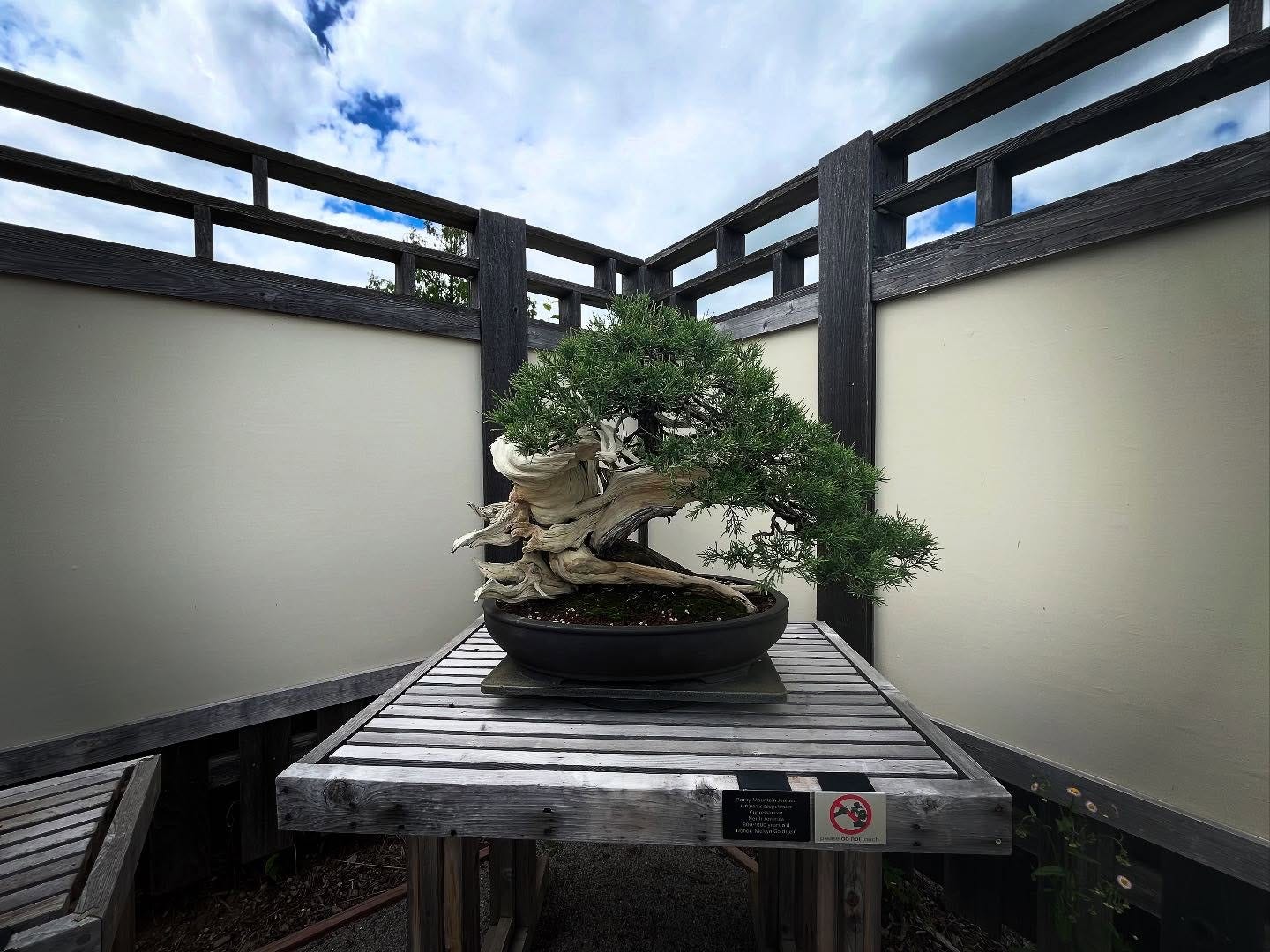
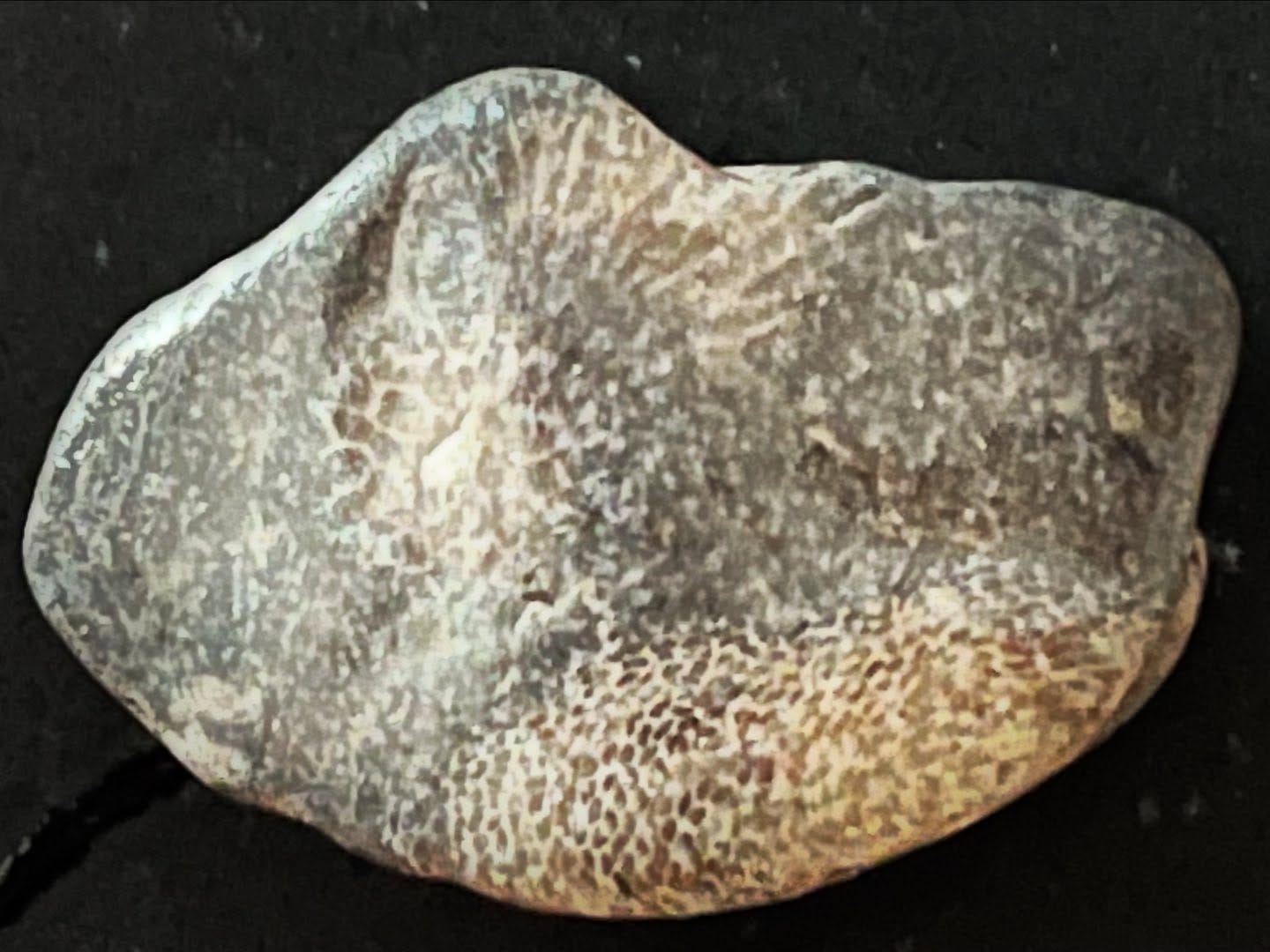
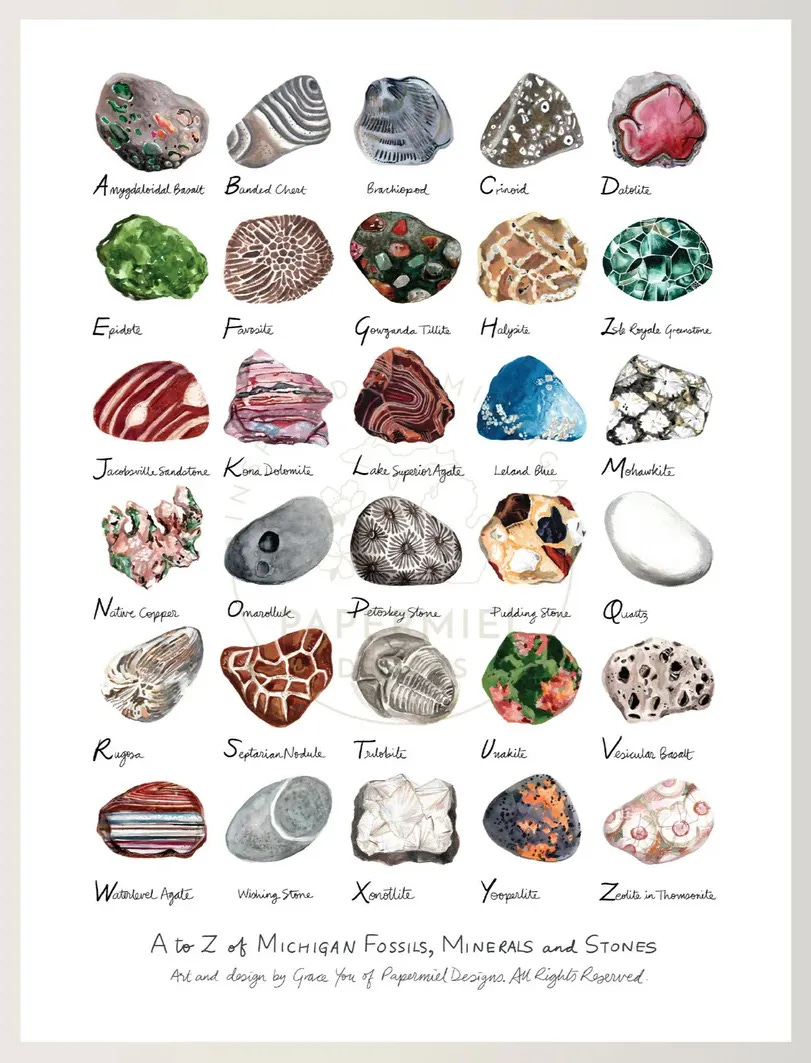

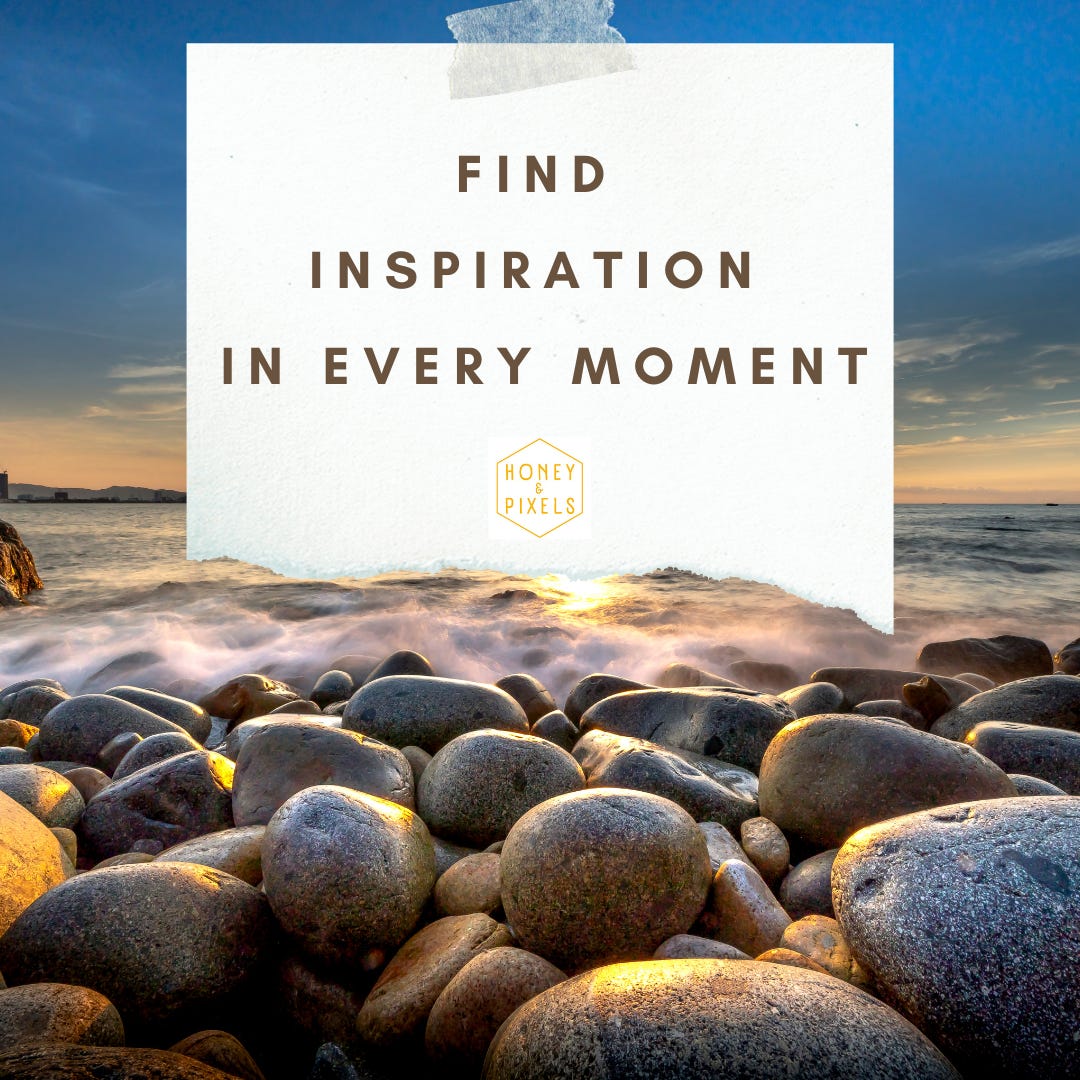
I love that you care so deeply about what happens to your plants!
A few years ago I was dumping our trash into our condo building’s interior trash room when I saw that someone had dumped a sickly plan to die. Not on my watch! I brought her upstairs to our place, where I nursed her back to health over 6 months.
I also had a different plant, a peace lily who I had named Fiona (I name everything.) Peace lilies don’t do well in the dry San Diego climate, so this poor girl slowly declined over 2 years.
When we moved from that condo, the buyer requested all of our plants, but wasn’t going to move in for another 2 weeks. I knew Fiona wouldn’t make it without love for that long, so I snuck her with me. We stayed in a hotel for 3 grueling months, where I barely kept her going.
Once we got into our new home, she wasn’t doing so well. I nursed her, I talked to her, I cleaned her leaves, I even took her outside for a little while each day for a little extra sunlight.
Then one day, with only the tiniest little patch of green left, she was gone. I cried like a baby.
So I get it. 🌱💚
What a great road trip!! ❤️